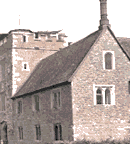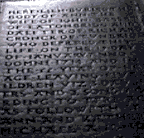There is much about England that I do not know. What does a real hedge look like? Why doesn't Labor ever win elections? Why do the British feel that British humor is funny?
In any event, we slowly wake up and make our ways into the car for a quick tour of Kent. There had been some thought of visiting Canterbury, but the Sassoons were pretty down on Canterbury as "tourist central." Instead, we did what I enjoy best. My hosts took me on the rounds of some of their favorite places to show off, chatting all the way about life in Kent and how it was when they were kids and what was significant (for instance, how high the dirt below hedges was once they had been in use for a few hundred years or a thousand years, leading to roads that felt almost belowground in places), and taking favorite byways through obscure paths.
We stopped first at  Igtham Mote, which I had heard as "item mote." This was an old moated castle that is currently being restored, and has begun charging for tours. The Sassoons were outraged, so we just walked out a bit outside. No matter. It was lovely, and absolutely, at least in my mind British.
Igtham Mote, which I had heard as "item mote." This was an old moated castle that is currently being restored, and has begun charging for tours. The Sassoons were outraged, so we just walked out a bit outside. No matter. It was lovely, and absolutely, at least in my mind British.
After some more touring, part of which consisted of critiquing the local pubs (but none of us were particularly moved to explore another pint or pub food for lunch) we store by a place that may have been called Soar Keep. This was a stone house built in the 1200s. For its time, it had all the mod cons--a latrine on the second floor that fell to the first where the servants could clean it out, a nice little chapel, a good winding staircase that would be easy to defend if roving robbers made it past the good arrow egresses--not an undefended corner in the place! In fact, the house was built so well that it was still in use as a storage area, long after the family and successive owners had moved into a succession of manor houses over the centuries. Eventually, in the last few years, it wound up in the "National Trust," and was now a bit of a museum, complete with one room given over to charts and drawings and text explaining the history of the place and the times in which it was built.
Eventually we would up in Penshurst, a somewhat touristy town, but with a better church (our second of the day) to explore. It was here that I was apprised of the difference, for instance, between Tudor homes (no square corners anywhere--they couldn't in those days), and Mock Tudor, a more recent invention in a category not dissimilar to Mock Turtle soup.
In ye olde village shoppe we picked up some postcards and I got some homemade "dragon's breath" mustard for the next stop.
Ducking under some mostly authentic Tudor, and passing through the village ye olde cemetery, we found our way into the church. Inside, in addition to the usual, were stones in the floor where local notables had, on occasion, been buried. Neither Sassoon had a good explanation of who got buried there when; it was clearly rare, but Rosemary told me about roving folks making rubbings of the  stone and bronze markers. This is but one more authentic British, slightly eccentric, hobby. They come in a series. Collect them all.
stone and bronze markers. This is but one more authentic British, slightly eccentric, hobby. They come in a series. Collect them all.
Eventually, our stomachs took us home or lunch, a tour of a wonderful vegetable garden, and goodbye. Next stop, Hamburg.